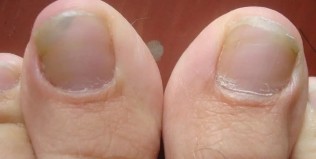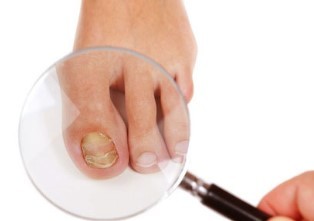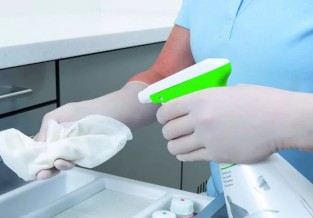There is hardly a man, never which the pathology, such as nail fungus. Someone familiar with the diagnosis by advertising pharmacological agents, and someone to learn about the disease first-hand, going out of the office of the dermatologist, or by yourself from the diagnosis.

Definition
The medical term onychomycosis (lat. onychomycosis) in translation from Latin means fungus, and serves as a designation of infectious disease by a fungus of nature. This is the most widespread in the world, the defeat of the nail and adjacent to that of soft tissues: according to the statistics of the world health organization (who) fungal infections of the foot suffers approximately 27% of the people, and this figure is almost double the amount of fungal infections of the nails on the fingers of the hand.
Kinds of fungal infections of the nail
Onychomycosis accepted categorization in the appearance of the affected areas. As a sign of the classification act of what looks like fungus on the nails, it is differentialsa in three types, depending on the clinical manifestations:
- atrophic, or onycholitic – in which nail plate is influenced significantly by the extent of the rejection of the nail bed?
- hypertrophic type, in which it lost the natural shine of the nail change color (turn white or, rather, darkens) and structure (bigger thicken) with the appearance of a different kind of distortion and even destroyed by the edges?
- normotroficheskie – kind, is characterized by a smaller extent of the defeat, during which the nail plate does not thicken, remaining shiny and smooth, but externally, it is transformed by the appearance of spots, streaks and other visible changes of the physics of transparency and color.
There is another classification, according to which the fungus in the nails is divided into types depending on the specific site of the defeat:
- overall, in which disease-causing process covered the whole nail plate?
- the far – form of defeat only to the free edge of the nail, which top pad of your finger;
- near, during which it destroyed the edge of the plate, that comes out from the bottom of the pad (opposite the free edge of the nail!);
- a lateral form of destruction, affecting the sides of the nail.

It looks like pathology
Common among the population fungal infections of the nails have external similarity of other dermatological diseases are not fungal in nature. Depending on the stage of the pathology, the nails begin to look unhealthy, as well as lose its natural glow and transparency.
From sleek and smooth, become more thick and deformed, and covered by a different color (usually white or dirty yellow) bloom. Soft fabrics, destructible parasite keratin layer, also participate in inflammatory reactions, swelling.
If we take into account the image of the destruction of the nail in view of the dynamics of the disease, the conditional can be divided into three successive stages:
- In the first stage almost no trace, except for the easy to tarnish, spots, or bands on the recording.
- In the so-called intense stage, fast-paced in the home, all the symptoms onychomycosis becomes evident.
- Advanced phase is marginal degeneration nail, can be enhanced with the advent unpleasant smell of decomposing tissue.
Symptoms of fungi in the nails
The appearance of symptoms of fungal growth corresponds to a conditional year of development, pathogenic process, the speed of which depends on the particular type of pathogen, and the individual characteristics of the state of health of the ill.
So, how to fix a fungus on your nails before the visit of the cabinet of dermatologist? Carefully look at a typical symptoms, which accompany the fungal infection of the nail plates in the alert:
- First nail lose its glossy luster, to become dull and rough.
- Then, from the transparent and pink nail changes color, becoming whitish, gray or dirty yellow.
- Thickness of plate is increased.
- On the surface of the body shown defective zones, the waves, irregularities, twists and etc.
- The nail appears fragile, it begins to exfoliate and crumble.
- His fingers due to the inflammatory processes begin to produce an unpleasant odor.

In the end, completely ruined nail is submitted onycholysis, i.e. peeling, exposing pringtime bed.
Causes of onychomycosis
The pathology is one of the manifestations of the growth of fungi, presenting a defeat in this case nail micro-organisms-dermatophytes-one (or several!) of the three genera:
- Microsporum (a type of canis);
- Trichophyton (species rubrum – 90% of all fungal infections, mentagrophytes, interdigitale, and tonsurans) – the most common stimulators of fungal infections;
- Epidermophyton (kind floccosum).
The representatives of the three labor, united collective in the name of "nail fungus", when ingested colonize (i.e., localized) dead skin derivatives of the epidermis of the skin:
- the fingernails?
- hair.
The reason is the selectivity property of micro-parasites lies in their diet: all representatives of the as a source of energy using fibrillar protein keratin, while destroying nails and hair.
Ways of infection
All kinds of pathogens of pathogens that are transmitted method of communication:
- the physical contact from an infected person to a more healthy?
- through things, blocks that contact with dead body parts (shoes, items of a personal household, etc.).
Contact with the nails or the skin, which has become a place of residence of the parasite, allows live representatives of fungi in the healthy parts of the body.
In this case, to pathogen onychomycosis could carry out penetration in human tissues, required conditions, such as:
- destruction of the integrity of the skin (dermatitis, diaper rash, vascular and skin diseases, abrasions, wounds, etc.)?
- a weakened immune system?
- the presence of concomitant diseases (genodermatosis, and hemolytic disease of the immune and endocrine system disorders);
- download cytotoxic and hormonal drugs, as well as antibiotics.

In connection with the above, to get a parasite in the body of a healthy person is not in all without exception cases leads to clinical manifestations of the disease, or only extremely weakly marked forms of pathology.
Because of certain individual terms, including a strong immune protection, the man, remaining outwardly healthy, it becomes a carrier of the parasite, infecting other people.
How to recognize the disease
For the reason of external similarity mycotic defeats with mechanical deformities and the symptoms of other diseases of the nail, on the basis of the clinical diagnosis is not only external signs — it looks like nail fungus — and even complements the results of micro-research.
For laboratory tests used particles phase of the nail, which produces a scraping of the nail fungus special tools.
The specific type of pest is detected with the help of two of the most useful research:
- culture, through the facilities of a biological sample of the affected tissue in a special nutritious environment?
- molecular biological method, or the so-called polymerase chain reaction (PCR).
More accurate and informative DNA-diagnosis is still quite widespread.
For the answer to the question: "how to recognize nail fungus at home," the experienced dermatologists advise to contact a specialist to conduct a comprehensive, and in necessary cases, and differential diagnosis.
From dangerous fungus nail
Simple nail fungus symptoms, even unpleasant, but traditional for fungal infections: a package of nail, pain, etc.
But in some cases in mycotic can be connected, for example, a bacterial infection, or the disease may occur abruptly, with the appearance of the bubble, ulceration, weeping phase in adjacent soft tissues.
Happens, medical treatment, long-term sought outpatient (over 16 weeks!), is not insufficient, and the disease progresses.
From dangerous fungus of the nail, the long-term is not amenable to treatment? In the inflammatory process of involved organs and their systems, and then may need additional hospitalization of the patient.
Treatments for fungal infections of the nails
In the early stages of the disease, the official medical follow conservative methods of bound drug treatment.
Anti-mycotic drugs that are intended to destroy the fungus under the nail, contain substances that can actively suppress activity of various seals. To achieve effective treatment can be used different pharmacological forms, sometimes part of total:
- tablets to be taken orally (through the gastro-intestinal tract, usually water), is granted when there is no desired effect from the external medicines;
- ointments, pastes and gels for topical use, with the application of the drug directly to the affected area pest part of the body?
- spray?
- solutions (resorcinol, boric acid, brilliant green, etc.) and suspensions, for applications soaked by means of paper towels on the affected areas, or the use of the drug in the form of thermal baths.
Drugs for external use is usually used two times a day, until the authorisation of clinical manifestations. In the event of a significant keratosis to facilitate the penetration of the pharmaceutical form deep stratum of education carry out the partial detachment. If the symptoms of fungal nail show the accession of secondary bacterial infection, in patients it is recommended in conjunction with antibiotics.
Important! If resort system Anti-mycotic in, to control for potential operational disruptions necessarily produce the biochemical study of the liver (analysis of blood serum for the presence of bilirubin, in the presence of the enzyme aspartate aminotransferase, gamma-glutamyltransferase, etc.
If the patient, therapist, for example, a fungus in the big toe, appear suddenly in acute inflammatory processes and/or intense itching, resorting to the media:
- antihistaminicas (from the edema and inflammation);
- desensitize (decrease sensitivity).

Treatment with the use of pharmacological agents, as a rule, is a course and occupies the time interval of at least three months!
The duration of treatment is explained by the introduction of the pathogen in the structure of the nail, in relation to what is required for the update, with a gradual consistent with the circumcision of the affected. In the event that the disease is at a stage in which the pharmaceutical treatment does not give positive results (integral form), or the patient – the person senile age, resort to radical methods, by removing surgically the ruined parasite nail.
Prevention
The best treatment is preventive activities, given that the prevention of the disease is much easier than first to spot the fungus on the nail, and then to get rid of it. Good ways to prevent infection is favored strict adherence to the rules of personal hygiene, especially in public places, the imminent danger of possible contact with the bodies of the fungal growth, as well as the prevention:
- primary, as an exception to abnormal dryness of the skin, abrasions, minor injuries, and hyperhidrosis, and in case of their occurrence – early treatment, for example, aluminium hydrochloride 15% with ditilinom glycol 1% when the excessive sweating of the feet;
- secondary – disinfection with special solutions objects in contact with a source of fungal growth (shoes, towels, etc.).
Placing true information, by which it appears the fungus on the nails, very likely to protect yourself and your loved ones from being infected, and in the case of the disease in a timely and adequate treatments are able to accelerate the recovery.































